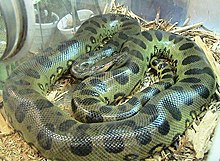Eunectes murinus
| Green anaconda | |
|---|---|
 |
|
| Scientific classification | |
| Kingdom: | Animalia |
| Phylum: | Chordata |
| Class: | Reptilia |
| Order: | Squamata |
| Suborder: | Serpentes |
| Family: | Boidae |
| Genus: | Eunectes |
| Species: | E. murinus |
| Binomial name | |
|
Eunectes murinus (Linnaeus, 1758) |
|
| Synonyms | |
|
|
The green anaconda (Eunectes murinus), also known as the common anaconda and water boa, is a non-venomous boa species found in South America. It is the heaviest and one of the longest known extant snake species. The term anaconda often refers to this species, though the term could also apply to other members of the genus Eunectes.
The green anaconda's scientific name is derived from the Greek εὐνήκτης, meaning "good swimmer", and the Latin murinus, meaning "of mice", for being thought to prey on mice.
The green anaconda is the world's heaviest and one of the world's longest snakes, reaching 5.21 m (17.1 ft) long. More typical mature specimens reportedly can range up to 5 m (16.4 ft), with the females, at around a mean length of 4.6 m (15.1 ft), being generally much larger in adulthood than the male, which averages around 3 m (9.8 ft). Weights are less well studied, though will reportedly range from 30 to 70 kg (66 to 154 lb) in an average-range adult. It is the largest snake native to the Americas. Although it is slightly shorter than the Reticulated python, it is far more robust: the bulk of a 4.5m green anaconda would be comparable to a 7.4m reticulated python.Eunectes murinus is probably the heaviest extant species of snake or squamate in the world, perhaps only rivaled by the Komodo dragon. Reports of anacondas 35–40 feet or even longer also exist, but such claims need to be regarded with caution, as no specimens of such lengths have ever been deposited in a museum and hard evidence is lacking. A $50,000 cash reward is offered for anyone who can catch an anaconda 30 ft (9.1 m) or longer, but the prize has not been claimed yet. The longest (and heaviest) verified specimen encountered by Dr. Jesús Antonio Rivas, who had examined thousands of anacondas, was a female measuring 521 cm (17.09 ft) long and weighing 97.5 kg (215 lb).
The color pattern consists of olive green background overlaid with black blotches along the length of the body. The head is narrow compared to the body, usually with distinctive orange-yellow striping on either side. The eyes are set high on the head, allowing the snake to see out of the water while swimming without exposing its body.
...
Wikipedia
